Are you traveling to Medellin and don’t know where to start? Don’t worry. The first thing to know is that Medellín is the city of eternal spring. There are many touristic and emblematic places.
The City of eternal spring
Medellín is the second-largest city in Colombia after Bogotá and the capital of the department of Antioquia. It is located in the Aburrá Valley, a central region of the Andes Mountains, in northwestern South America.
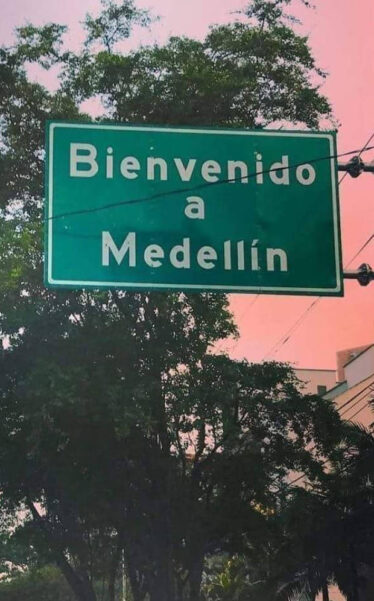
Coffee lovers will love Medellín. It is the capital of Antioquia province, which is famous for its coffee plantations and flower farms.
Medellín is consolidating its position as a modern city rich in tourist, cultural, and commercial activity. It has 22 museums and six library parks, more than 25 shopping malls, six gastronomic areas, and an array of important medical facilities that make the city a center for health tourism.
The weather is almost perfect, hence its rather lyrical nickname of ‘The city of eternal spring’. With year-round average temperatures of around 22°C (72°F) and daily highs of over 30°C (86°F).
Medellín’s climate is as good as it gets. It rains quite a bit, as in any tropical country, but it is never cold. If warm weather and a pleasant climate are important to you, Medellín meets all the requirements for good weather!
You are surrounded by natural beauty and health.
Medellín is the capital of Antioquia, Colombia. It is a region crossed by the central and western mountain ranges, which makes it a mountainous region with a high agricultural and livestock vocation, with commerce, industry, and tourism being other of its main economic activities.
Antioquia has a total of 125 municipalities, 20 of which are considered magical towns (Arboletes, Barbosa, Caldas, Cisneros, Concepción, Dabeiba, Donmatías, El Carmen de Viboral, Entrerríos, Gómez Plata, Guatapé, Jardín, Jericó, Marinilla, Necoclí, Puerto Berrío, San José de la Montaña, San Vicente Ferrer, Santa Fe de Antioquia, Santo Domingo, Sonsón, Támesis, Turbo, Urrao, and Venecia), of which three are also heritage towns of Colombia: Jardín, Jericó, and Santa Fe de Antioquia.
Important Information
At the beginning of the 20th century, Medellin was the center of industrialization in Colombia with a great variety of factories located in the city.
It is important to recognize that in the 1970s, Medellín suffered the greatest economic and social crisis in its history.
Young people lost their jobs, there was no possibility of raising families and crime rates soared. Consequently, it became the perfect breeding ground for the rapid establishment of a drug trafficking network: in 1976 the Medellin Cartel was created, with its kingpin Pablo Escobar at its head.
During the 17 years, it was in operation, it turned Medellin into the most dangerous city in the world. The city had a homicide rate of up to 381 per 100,000 inhabitants in 1991. The city lived an open war not only against the police but also between the cartels themselves.
In 1993, Pablo Escobar was killed, but this was not the end of drug trafficking. People were fed up with so much violence. Little by little and with the help of all the organizations, Medellin has been able to overcome its terrible past, being in this XXI century one of the best cities to live in the world and one of the most innovative.
But, even if such horrible things took place in the eternal spring city, Antioquia’s capital is much more than that and the list of things to do is varied and could go on and on.
It is a special city, the atmosphere of its streets, the style of some of its neighborhoods, and the friendliness of the paisa people. The moment you arrived in that city, you immediately feel like you are in a familiar place.
Moreover, in recent years a great effort is being made to recover the “livability” of the city, with a sustainable development plan that has been applauded and awarded internationally. Today Medellin is a place with lots of cultural spaces, cool neighborhoods, and a good number of attractions.
Social innovation was one of the city’s efforts to improve the quality of life of its citizens. In 1991, with the drafting of the new anthropocentric constitution, actions were focused on strategic plans that translated into greater investment in education, innovation, and social inclusion.
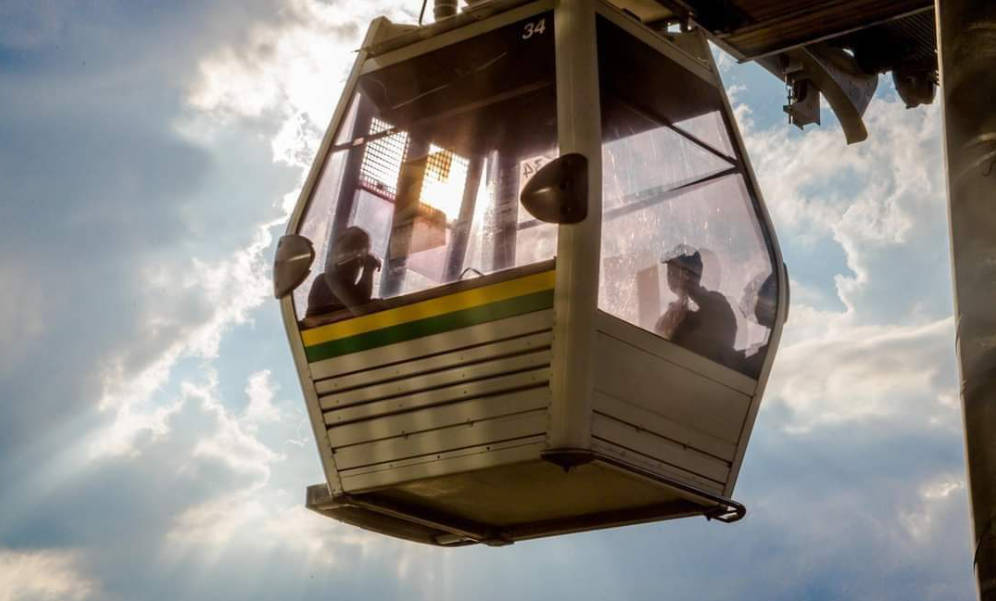
Among the city’s mega-projects, the Metro Mass Transit System is perhaps one of the milestones that most marked the city. The pride of the people of Antioquia. Later, it was joined by the metro-cable feeders, the metro-plus, the tramway, the bicycle lanes, and the escalators in Comuna 13, which changed the face of a neighborhood in front of the world.
Another bet the city made to generate a culture change was the Medellin Public Library System and the Articulated Life Units (UVA) that work with public institutions, and organizations and are today centers of citizen transformation that respond to specific needs.
So, traveling to Medellín is safe, its history of violence is behind it and today Medellín flourishes thanks to its social and urban transformation, which can be witnessed in important tourist sites in the city, such as Comuna 13 or the Casa de la Memoria Museum, among others.
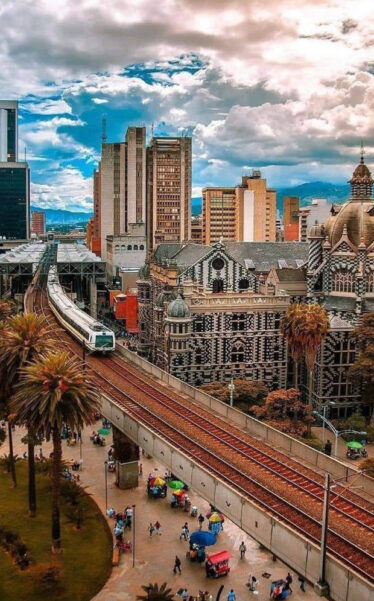
In fact, according to figures from the Security and Coexistence Secretariat of the Medellin Mayor’s Office, as of October 2022, Medellin had a homicide rate between nine and ten points below the national average, as well as a 50% decrease in the last four decades of violent deaths of young people between the ages of 14 and 28.
As in any destination, there are some places and times to be more vigilant, as well as in general, take care of high-value personal items such as jewelry, cameras, and cell phones, and avoid carrying large sums of money.
Medellín was named ‘Innovative City of the Year‘ by the Wall Street Journal in 2013, and that amazing innovation is visible throughout the city.
You can ride the Metrocable cars to previously isolated neighborhoods, visit the many science parks and libraries scattered throughout the city, or explore the Comuna 13 neighborhood with its series of urban escalators.
Medellín’s policy of social urbanism, aimed at incorporating previously alienated citizens into the city and investing heavily in progressive architecture and education, has been heralded around the world, and the opportunity to experience it firsthand is a great reason to visit the city.
Details make the difference
Lets us start by asking: what is the best time to visit Medellín?
Honestly, it depends! For those who prefer the heat, the best time to visit Medellin is between mid-December and early March, the hottest time of the year. However, the weather is always so pleasant, that visiting Medellin will always be a good idea.
Likewise, for those who love cooler temperatures, the period between early October and mid-January is ideal.
Something very particular about Medellin and Colombia, in general, is that, in the same region and a few kilometers away, it is possible to easily change the thermal floor, which makes it an exceptional destination in which its multiple climates are one of the expressions of its extensive diversity.
Other amazing facts are that as expected food is delicious. Medellín is full of restaurants with spectacular dishes, and we recommend trying the famous Bandeja Paisa, which will take your senses to another level.
Since around 2010, Medellín has benefitted from:
- Creative urban living ideas
- Experimental parks
- Excellent public transport
- A return of locals that left during the “bad” years
The common theme in the revival of Medellín is a source of pride from the local people when it comes to backing public projects. Medellín’s recent rise could be described as a modern renaissance.
The revival of Medellín’s public transportation system helped reunify a city that was previously fractured by violence and corruption.
Also, modern architecture, mixed with a blossoming of artistry and an emphasis on community, has led to the birth of a hot destination.
Amazing places to discover
There are some amazing places to discover around this city. We will start at Plaza Botero, situated in the heart of the historic center. There you will find the Parque de las Esculturas, an open-air art gallery, where 23 sculptures of considerable size and that recognizable style of large volumes of the local artist Fernando Botero are exhibited.
Visiting this park will be one of the best things to do in Medellín with children: they will be amazed by the sculptures and it is a very pleasant place.
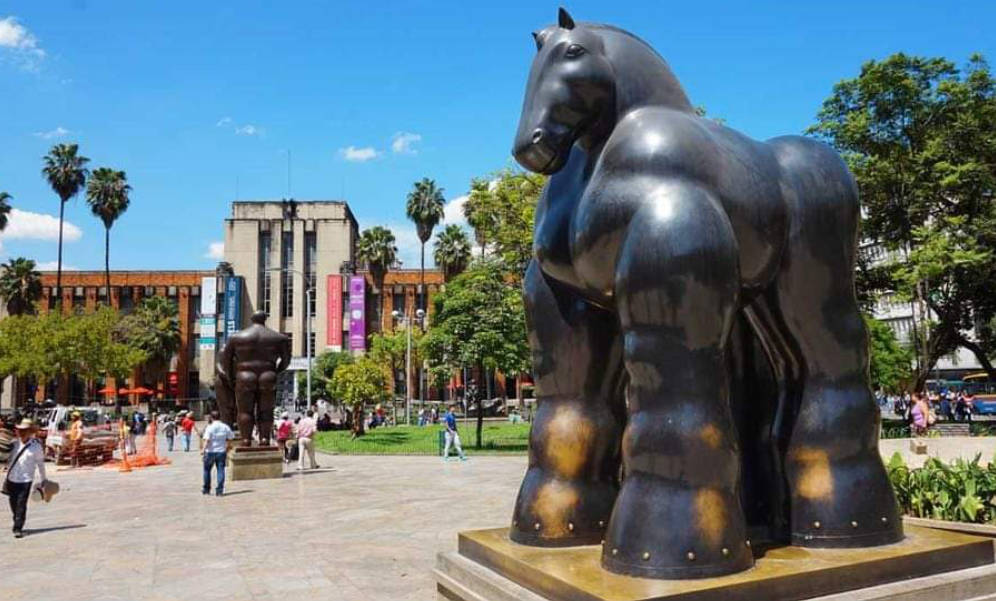
Originally, it was the headquarters of the government of Antioquia. But, today it is a must-see landmark for visitors and locals who are interested in learning more about the history of the city. This place is an important point of transformation and memory.
You can find 23 bronze sculptures of the artist Fernando Botero that gave the name to this square.
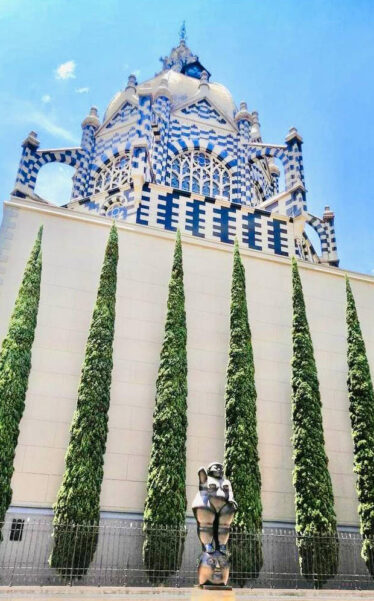
In this open-air museum just a few meters from the Parque Berrio subway station you can find the most representative works of Botero as La Mano, Hombre a Caballo, and Soldado Romano, amongst others.
In this square, you can also find the Museum of Antioquia, founded in 1881, which preserves in its interior paintings, sculptures, photographs, drawings, and other pre-Hispanic, colonial, and contemporary works of art.
This particular museum is located in the center of Medellín and houses collections of international relevance. In 1995 it was declared a national monument.
In the same square, there are a couple of places you can’t miss. The first is the Palace of Culture Rafael Uribe Uribe. It is one of the most beautiful buildings in the city, plus you can go in for free!
One of the most important meeting points is Berrío Park, considered the soul of Medellín, which is an amazing urban park.
The Cathedral is breathtaking. is a Catholic cathedral dedicated to the Virgin Mary under the title of the Immaculate Conception.
It is located in the central zone of Medellín (Colombia) in the Villanueva neighborhood on the north side of Bolívar Park. Additionally, the temple was formerly called and is still known but to a lesser extent, as Villaneuva Cathedral, especially during its construction to distinguish it from the Basilica of Our Lady of Candelaria, which was the seat for the Episcopal see at the time.
Its brick structure is perhaps not one of the most impressive in Latin America, but it is visited by dozens of people daily to see the Virgin Mary, so inside the Cathedral a particular atmosphere is created. In my opinion, it is not a “must” visit in Medellín, but if you are interested in religious worship during your travels, this is an interesting place.
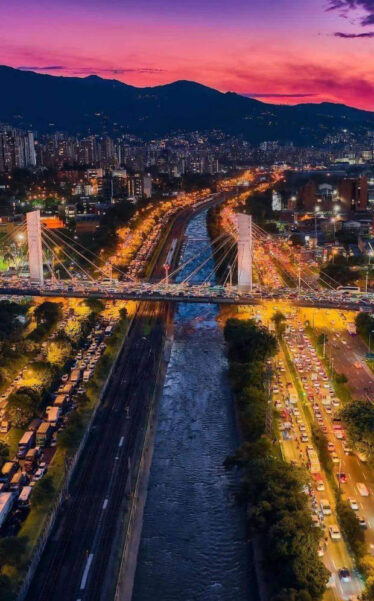
I find that it is worthwhile to climb the hill to see Medellin from above.
If you go at sunset, the colors of the city become more orange and you will also find more life and atmosphere in the park.
It was inaugurated in 1994. The park has a commercial area, an amphitheater, a wide-open plaza, and a landscaped park located in front of the San Antonio de Padua Cathedral.
San Antonio has several sculptures by the famous Colombian artist Fernando Botero. The destroyed remnants of his statue titled the “Pajaro de Paz (Bird of Peace)” sit next to an identical replacement as a reminder of the park’s violent history. The story behind it is that, in 1995 a 10-kilogram bomb exploded right at the foot of this sculpture, taking the lives of 23 people, in one of the last attacks of the drug war. It was decided to rebuild the monument and accompany it with a new identical sculpture by Botero, the Bird of Peace, so as not to forget such a bloody past.
An interesting place to visit in Medellín is the Parque de las Luces. This breathtaking public park was once a rather dangerous part of Medellín. Today, 300 illuminated pillars stand in the space, providing shade by day and light by night.
The area now occupied by Parque de las Luces is also known as Plaza Cisneros. It was here that farmers and traders gathered to sell their wares, and where the train came in from the countryside, laden with goods to unload at the train station just across from the market.
The city that keeps on giving
Medellin is the city that keeps on giving. Besides the amazing food, climate, location, history, past, present, and future, some places just keep evolving and making it so much more wonderful than expected.
Comuna 13 was once one of the most dangerous neighborhoods in one of the most dangerous cities in the world. Fortunately, today it has been given a facelift and this commune can be visited thanks to tours that take you to see its most artistic side.
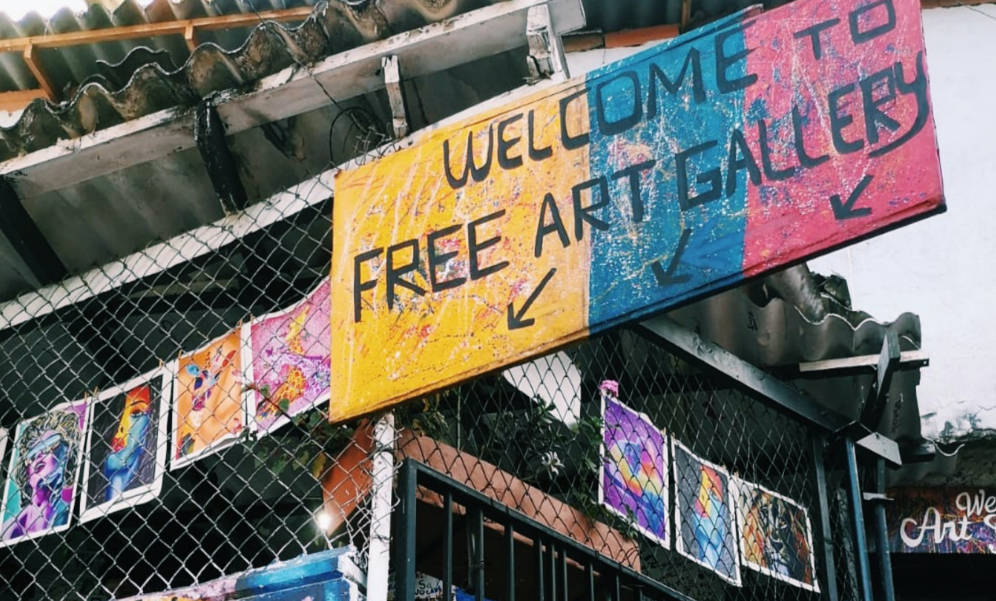
Here the guns have been exchanged for spray cans, in a program of social inclusion for the most disadvantaged.
So if you like street art, do not miss it, what’s more: you can sign up for a free tour with a meeting point at the Metro station San Javier.
And if you want to still be amazed because you haven’t had enough you should head out to Arvi Park. It is the lung of Medellín and can be reached in two ways: by bus or metro cable. The most fun and interesting way is by metro cable.
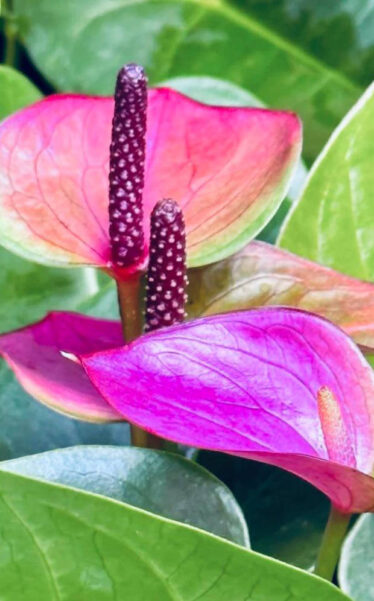
The ride costs 5.500col and the trip goes over the neighborhoods of Medellin to the forest.
It is very worthwhile to arrive from the air, and then walk along its paths full of towering trees and ferns.
This place is located in one of the five districts of Medellin: Santa Elena, which is characterized as an area dedicated to the cultivation of flowers and other products of the earth.
Something taht is really amazing is that it is both an ecological nature preserve and Pre-Hispanic archeological site on the eastern slopes of Aburrá Valley, in the northeast area of Medellín, Colombia.
The park covers several other municipalities of Antioquia, including Envigado, Bello, and Copacabana. It covers 16,000 hectares, 1,760 of which are in the state of natural forests.
It has 54 miles of walkable trails. It is a major tourist attraction, known for its wildflowers, butterflies and trails.
The park can be reached from downtown Medellín via the metro station. Line L on the Medellín Metro goes to Arví station, where there is a direct link to the metrocables that go to the park.
Ending for the moment
Sadly, we have to end this article. However, we have just scratched the surface.
Paisas, as the people of Medellín and Antioquia are known, are famous for their welcome and friendliness. Colombia is generally known as a country full of friendly people, but Medellin is definitely among the friendliest of all. It creates a pleasant atmosphere throughout the city and is another great reason to visit.

Maybe there is something special about this city, something that ticks differnt. After all, this city has been the birth place of many famouse people. Some of them are: KarolG, Maluma, David Ospina, Zulay Henao, amongst others.
Medellín has gone from being labeled the “most dangerous place on Earth” to a hotspot that welcomes travelers around the world. Local resilience in fighting crime and rebuilding the city’s image through public projects has played a big part in Medellín’s revival. Tourists who visit Medellín will be pleased to find a vibrant cityscape that is used to warm weather, good coffee, vibrant nightlife, and unique cultural celebration through art, music, and food.


